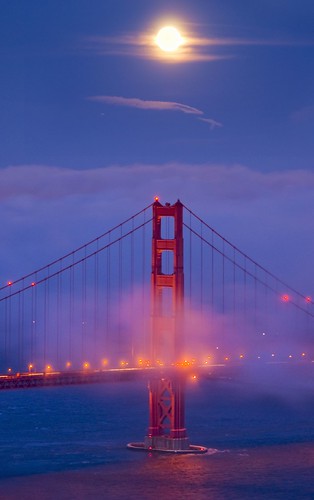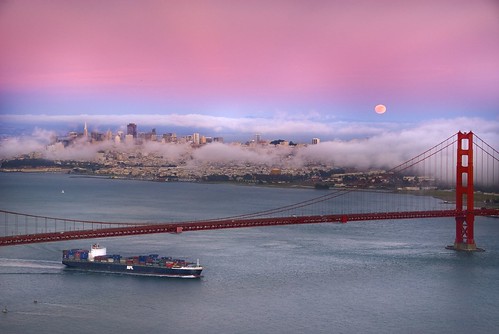At the end of June this year, the full moon rose in the eastern sky at about sunset (although by July 2 after dark). This cosmologic timing gave me the chance to consider extravagant dynamic range. In other words, what can you do with captures in which the dynamic range is simply too great to process for both bright areas and dark areas?
It’s always best to start with the best capture possible. This is less of a tautology than it seems, and is often ignored by photographers who think Photoshop can fix anything.
In fact, post-processing can fix many problems with the range of an exposure. But the contrast between a bright full moon and a landscape at dusk (or in darkness) is immense (see the photo below). As a first pass, a full moon nicely lit by reflected light from the sun at ISO 100 should expose properly at about 1/250 of a second and f/8. An evening landscape might properly expose at ISO 100 at 15 seconds and f/4 (if it is a cityscape with some ambient sunset light remaining) to 30 seconds and beyond if it is a true night landscape.
View this image larger. Read the back story featuring this image.
This extravagant dynamic range is greater than you’ll find in most photographic situations, and well beyond the capabilities of RAW multi-processing. RAW processing gives you -4 stops to +4 stops in dynamic range, although this entire eight f-stop range is not usable due to factors like noise introduction (it takes considerable Photoshop skills to even get close).
Back of the envelope, the eight f-stop theoretical range within a single RAW exposure proves a dynamic range of 2^8 (or 128). As I just noted, this entire range is not practically usable. In contrast, the dynamic range between bright moon and night sky is about 3,000 (the number you would need to multiply 30 seconds at f/4 to get to 1/250 of a second at f/8). It’s easy to see that you can’t expose a single digital RAW capture for both ends of this 3,000:1 ratio.
But wait! Isn’t there a good solution to this problem using HDR (High Dynamic Range) merging tools? A Merge to HDR Automation ships with Photoshop that will automatically blend a whole exposure range of different captures of the same subject. If this interests you, you might want to consider a speciality tool (it comes standalone or as a Photoshop plugin), Photomatix, which uses tone mapping to create HDR blends of multiple exposures (and does a rather better job than the Photoshop automation). And, no, this is no panacea that deals with the problem in extravagant dynamic range between moon and night sky.
There’s some concern that HDR blends tend to look artificial. Leaving this aesthetic issue aside, there’s a bigger technical issue when it comes to the moon in the night sky. Namely, at least some of the exposures involved are going to be lengthy, probably well over a second. This time lapse means that you can’t take static multiple images (the moon will move from one farme to the next), and the HDR blend will not appear seamless.
Another post-processing technique to consider using with the bright moon and dark landscape is to simply fire off two exposures, one for the moon and one for the landscape, and combine them. For the record, this can be done with film as well as digital. And the problem here is that except in really unusual circumstances the results will look highly artificial.
So what is to be done? Photographers must fall back metaphorically on the cunning of the coyote and wolf, animals that enjoy the moon, and seek images that create attractive “natural” renditions of the dynamic moon-landscape spread within a single RAW capture. One strategy: employing softness so that is OK for the moon to lose details in the highlights (this is what I used in the photo above).
Another tactic: photograph the moon and landscape early enough so the dynamic range isn’t so extravagant (but things are clearly tending towards dusk). This may only give you a narrow time window of a couple of minutes, and it requires the right moon-rising time, but works for the photo below:
View this image larger. Read the back story featuring this image.


Pingback: Photoblog 2.0: » Photoblog 2.0 Archive: » Diffusion of the Moon
Pingback: Photoblog 2.0: » Photoblog 2.0 Archive: » Active D-Lighting on the Dipsea Trail
Pingback: Tone Poem | Photoblog 2.0